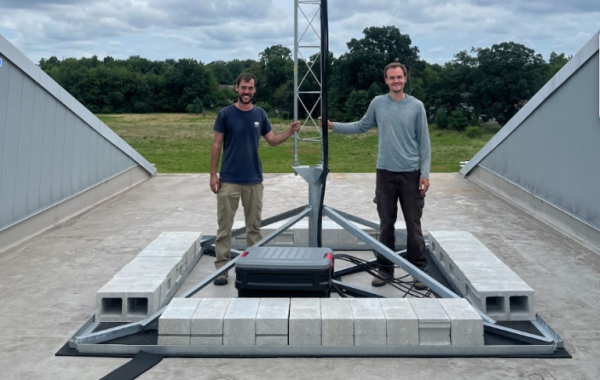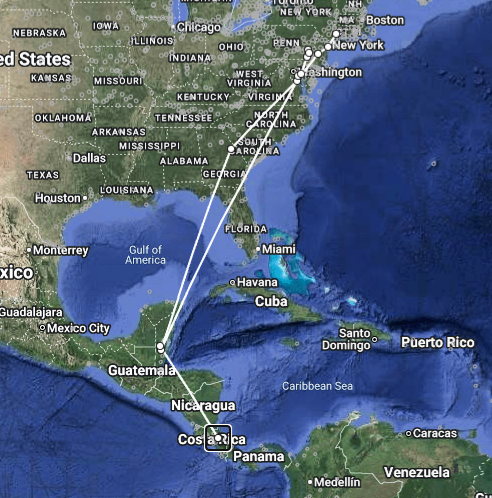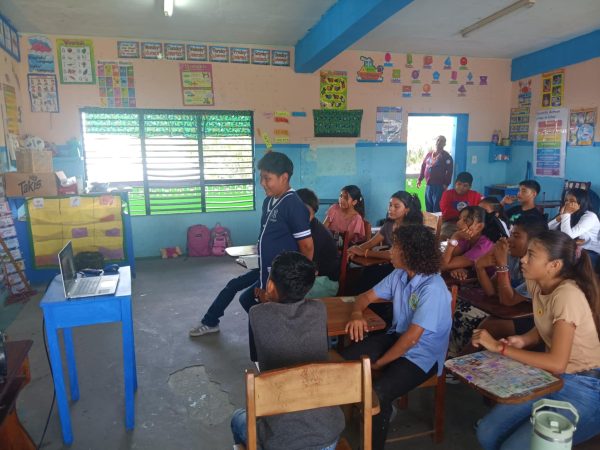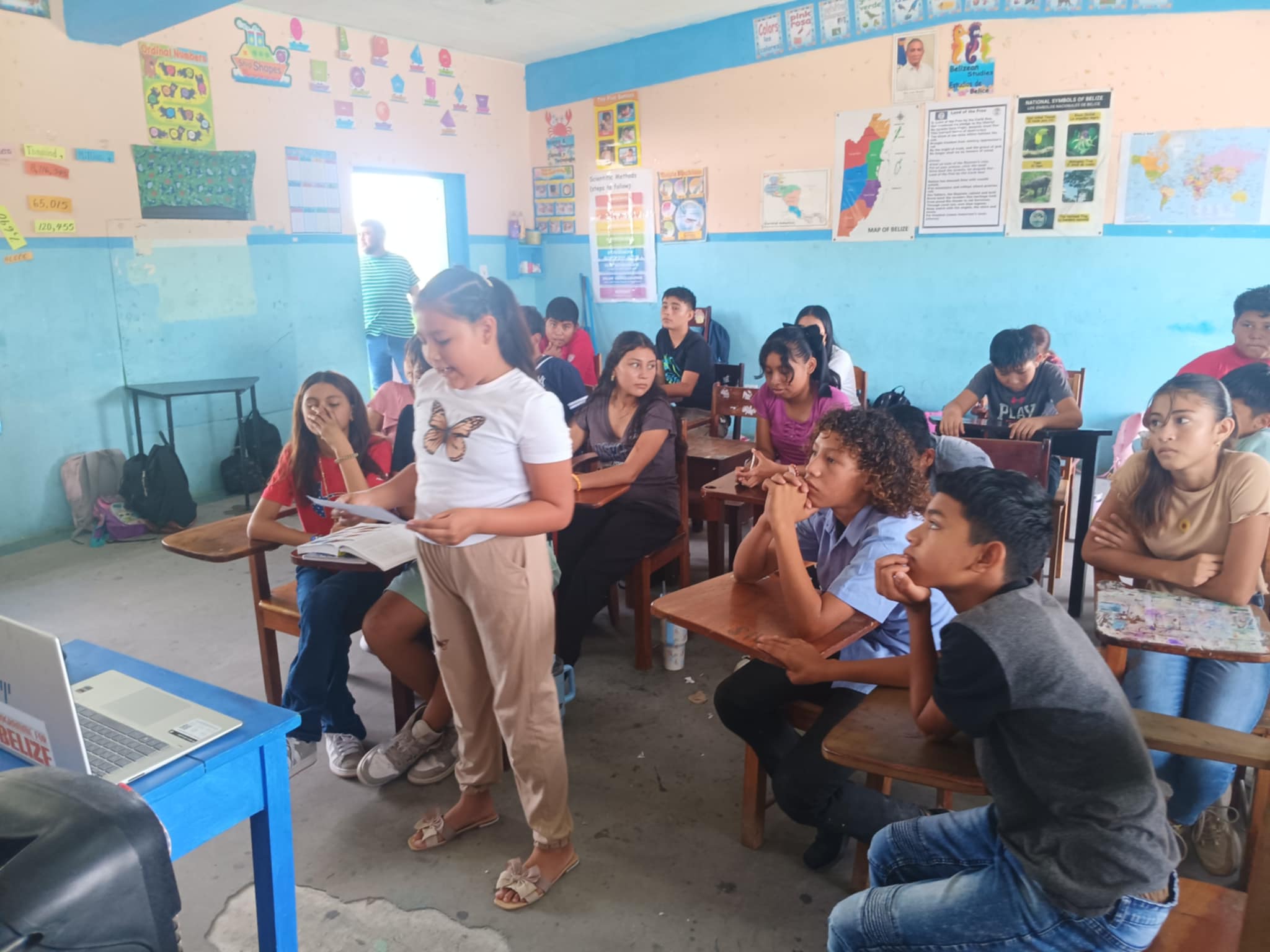This spring, two classrooms, one in Croydon, Pennsylvania, and the other in San Felipe, Belize, were brought together by an unexpected connection: a migrating Wood Thrush. Through the efforts of Heritage Conservancy’s Education Department and a network of international partners, students discovered that the same tagged bird had been detected at both of their local Motus wildlife tracking towers, sparking a meaningful exchange rooted in nature and conservation.
Motus Tracking and Learning
The Motus Wildlife Tracking System is an international research network that uses miniaturized radio transmitters and receiving stations to monitor the movement of birds, bats, and insects across the globe. With funding from The McLean Contributionship and the PA Department of Environmental Protection’s Coastal Zone Management Program, Heritage Conservancy was able to install Motus towers at both Keystone Elementary and Bucks County Community College, opening doors to both research and real-world learning for local students. “The Motus Towers are not only providing data for our local land management in terms of wildlife use at Heritage Conservancy preserves,” said Shannon Fredebaugh-Siller, Heritage Conservancy’s Director of Education and Community Programs, “but they are also helping students and community members to understand the critical role that local conservation has in the greater context of protecting the planet.”
It was through this tracking system that an interesting discovery was made: both schools had tracked the exact same Wood Thrush on its journey from Belize to Massachusetts.

Tyler Kovacs, Senior Conservation Biologist at Heritage Conservancy, with newly installed Motus tower.
Migration Journey

Flight path of Wood Thursh #52902 – map from motus.org
St. Michael R.C. School, located in the village of San Felipe in northern Belize, has been working in partnership with Programme for Belize, which manages the nearby Rio Bravo Conservation and Management Area. A Motus tracking tower installed at Rio Bravo detected Wood Thrush #52902 as it began its migratory journey north.
Months later, that same Wood Thrush was detected again, this time by the Motus tower at Keystone Elementary School in Croydon, PA, where Ms. Kati Bryson’s 4th-grade class has been exploring bird migration and local ecology through programs led by Heritage Conservancy. From bird migration obstacle courses to live animal presentations with AARK Wildlife, students have had the opportunity to connect with nature just steps from their classroom at Croydon Woods Nature Preserve, a Heritage Conservancy-owned property adjacent to the school.
A Global Connection
When Mass Audubon, who initially shared Heritage Conservancy’s bird migration curriculum with St. Michael R.C. School, learned of this shared bird sighting, they helped spark a cross-cultural collaboration. Facilitated by Shannon Fredebaugh-Siller, students from St. Michael R.C. School in Belize joined Keystone Elementary’s 4th grade class for a Zoom meeting, taking turns presenting facts about their classrooms, local birdlife, and the habitats that surround them.
Sofia, a student from St. Michael R.C. School said it best:
“Thanks for the opportunity to share with students from Keystone Elementary who are now our friends from Pennsylvania. We here at St. Michael RC School are grateful in being able to share in our knowledge and appreciation for the nature of our area and the importance of birds in our environment.”

Students from St. Michael School give presentations to Keystone Elementary students via Zoom
The journey of Wood Thrush #52902 was more than just a data point — it became a connection story for Pennsylvania and Belize students. Thanks to this unique collaboration, students from two different parts of the world had the chance to learn from each other, building a greater appreciation for wildlife and the role they can play in protecting it.
Vladimir Rodrigues, Technical Coordinator for Programme for Belize, works closely with the students and shares, “The collaboration is unique in that it has brought students together to better understand the role their respective schools contribute to the conservation work of the Wood Thrush. It has also allowed for students from each school to learn and gain a better appreciation for the culture and ways of life of the other. In many ways, we can say that conservation is working to bring students together.”
At Heritage Conservancy, we’re proud to support these kinds of experiences where science, storytelling, and stewardship come together to create lasting impact.
If you’re interested in Environmental Education programming or teacher trainings, please contact Shannon at sfredebaugh@heritageconservancy.org or head to our website to learn more.
